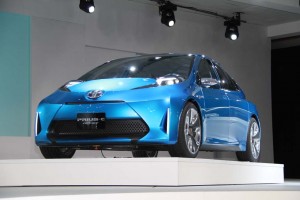
Some good news for Toyota, which kept its lead in the global sales sweepstakes. Can it hold that advantage as it expands its Prius line-up, in 2011?
It was a tough year for Toyota, but despite an assortment of setbacks, including a sharp slump in U.S. sales during the final months of 2010, the maker was able to hang onto its crown as the global king-of-the-hill for the third year in a row.
Adding sales of its Daihatsu and Hino subsidiaries brought Toyota’s total sales, for 2010, to 8.42 million. Though not the upturn the maker originally predicted, global volumes were still up 8%, giving the Japanese giant a 30,000 unit lead over its closest competitor, long-time sales leader General Motors.
GM might have been able to recapture the lead had it not sold off or shuttered the four North American brands it agreed to shed under its 2009 court-ordered restructuring. Though it was able to regain much of the volume lost with the closing of Saturn, Hummer and Pontiac, and the sale of Swedish-based Saab, the maker was off just enough to remain an also-ran in the global sales race.
Then again, Toyota might have widened its own lead had it not had to cope with the impact of an ongoing safety scandal that resulted from a score of recalls involving more than 11 million vehicles worldwide, the vast majority of them in the U.S. The maker paid a record $48.8 million in fines, last year, to resolve government charges it improperly delayed several recalls.
Despite offering some of the biggest incentives in its corporate history, Toyota saw sales decline during the final three months of 2010, the only major maker to record a sales deficit during a quarter when the industry began to show strong signs of recovery.
Whether Toyota will be able to reverse the situation in 2010 remains to be seen. The maker’s top American executive, Jim Lentz, asserted things have bottomed out and that internal measurements show the brand regaining momentum. But an independent study, conducted in early December by non-profit Consumer Reports magazine, found that perception of the Japanese brand had slumped sharply and was in a “statistical dead heat” with Ford Motor Co., which had made significant gains in terms of consumer perception.
Toyota expects to report a modest 2% increase in sales in 2011, to around 8.6 million, the maker said last month.
GM has not yet issued a forecast for 2011. How well it fares will likely be influenced not only by the recovering North American market, but also Europe – where its Opel subsidiary has been seriously struggling – and the booming Chinese market. (Experts predict China sales could top 20 million in 2010. Click Here for more.)
General Motors became the first automaker to ever sell more than 2 million cars in China during a single year, as of October, and reported a 29% increase in that market for all of 2010. Toyota has been moving aggressively to gain ground in China, but it reported a more modest 19% increase off a markedly smaller base last year.
There was a significant gap between number two GM and Volkswagen, which came in third in the global sales sweepstakes, hitting 7.14 million last year. The German maker has forecast a 5% increase in sales during 2011 for its numerous brands, which range from Spanish-based Seat economy models to the million-dollar Bugatti supercars – as well as flagship VW models.
But VW CEO Martin Winterkorn recently reiterated his long-standing goal of positioning the Wolfsburg-based “people’s car” company as the number one player, globally, by the end of its 10-year development program, in 2018 – if not sooner. The maker is investing billions in key markets such as China, where it has been locked in a decade-long battle for leadership with GM – as well as the United States.
VW has yet to match the sales peaks of the ‘60s, when the Beetle was the leading import in the U.S. market, but the maker hopes to nearly triple volumes by 2018, and believes that will be set in motion with the opening, this year, of the first Volkswagen assembly plant operating in the States in nearly three decades.
Who will lead the industry could, of course, be determined by external headwinds, as former GM Chairman Rick Wagoner liked to say – including fuel prices, but also the emergence of new competitors, notably from China. The potential for a switch to electric propulsion could also generate unforeseen shifts in the global automotive pecking order.
